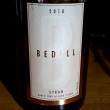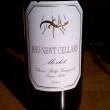A Tale of Two Niagaras
 By Bryan Calandrelli, Niagara Correspondent
By Bryan Calandrelli, Niagara Correspondent
Lately, it’s been frustrating for me to keep fresh information about Niagara wines flowing to the readers of LENNDEVOURS. I’ve written about a handful of wineries producing dry wines that I’ve been excited about, but I’ve dealt with some trepidation concerning some of the others in the region.
It’s the same feeling you might get when a new girlfriend comes home with you to meet your family. There’s always that one aunt or uncle that you haven’t quite mentioned before everyone meets face to face. Well, it’s about to get awkward as I introduce you to the Niagara region’s Aunt Hybrid and Uncle Vitis Labrusca.
I personally don’t find anything exciting about vitis labrusca, while at the same time, at least 1/3 of the wineries up here have more of these wines than vinifera. I’m sure there are more than a few great ones up here, perhaps the best in the state, but I just don’t know how to judge such things.
The bottom line is that they can be instant profit for these wineries. They can be quickly turned around, don’t require barrels and don’t demand the same attention as their vinifera cousins. When these wineries create a good sweet blend and market it with a catchy name, it can result in instant brand loyalty among its drinkers. I’ve seen wineries scrambling to keep them on the shelves when they’re done right.
Indeed, the sweet producers aren’t losing any momentum. How can they ignore this ability to shave years off the marathon race toward profitability? What do you do if those ubiquitous bus loads and limo trains tend to bring out the sweet drinkers (as is often the case here in Niagara)? Do you start sweetening your Riesling? Do you buy a few tons of Niagara or Catawba to satisfy the demand?
I’m not sure what the answer is yet. I do know that twenty years ago the Ontario government used subsidies to encourage pulling out native grapes and replanting with vinifera. They also formed the VQA (Vintners’ Quality Alliance) to brand and regulate dry wine to boost consumer confidence. And I still see plenty of sweets in the Finger Lakes, but they have so many wineries now, you could spend a week there just stopping at wineries that feature only vinifera.
Like I’ve said in recent posts, the best to come out of the Niagara region may still be in oak, stainless steel or on the vine. Young vinifera vineyards are coming online at an exponential rate, but if you do make it up here and only drink dry wines, be warned that you should do your research to see who’s pouring what. And if you forget to do that, just ask the tasting room employees where you can find what you’re looking for.


















Bryan, I would contend that even visitors to the Finger Lakes face the same situation. While there are a lot of wineries dedicated primarily to vinifera, these wineries are not clustered in one location, and therefore a visitor travelling down the road may encounter several wineries with a non-vinifera emphasis between wineries that offer dryer fair.
I guess each type of drinker should find their own place, no big deal. Where I think this is can be a problem for the industry as a whole is when a visitor who enjoys vinifera randomly selects a few stops and leaves the region disappointed or confused by the sweet stuff they’ve encountered. There are enough wineries to satisfy their palate, and yet the physical layout of the region has convinced them to not look to the Finger Lakes for future wine consumption. The lack of their purchasing loyalty hurts the industry as a whole, no matter what their personal tastes.
Hang in there-it’s nice hearing about the wineries in the Niagara region that are trying to make vinifera work for them.
We have the same issue in New England. I think part of the problem is that many of the dry vinifera wines are just, how can I put this…god awful. There are pockets of more established grape growers/wine-makers who have already done their trial and error and have zeroed in on the vinifera that can really do well in that locale. For others, the only vinifera varietals that are remotely palatable (particularly where reds are concerned) are the sweets.
Labrusca and Hybrid = sweet wine. Wrong.
“They can be quickly turned around, don’t require barrels and don’t demand the same attention as their vinifera cousins. ” DEAD WRONG. Just because that is how they are often treated dosnt make that true. I dont know what kind of wines you expect to produce working on that assumption. The only difference is we have had thousands of years to work with vinifera, and only a few hundred with labrusca and hybrids. Be patient grasshopper.
I did make an error in linking hybrid and native in the same thought. Hybrid grapes can be done dry with success.
Native grapes on the other hand are naturally more acidic and, generally speaking, need sugar to balance them out.
The fact that hybrid grapes are bred to be more cold hardy and disease resistant does in fact make them easier to grow and require less strategy when choosing vineyard sites.
Baco and Vidal are two shining examples of hybrids and I do feel that I shouldn’t generalize such a large class of grapes.
Thanks for the comments, they are much appreciated!
of course these are two different issues, wine makeing and grape growing.
Im only begining to learn winemaking, so I cant state with certainty how, but I know there are ways to work around high acid. The most obvious is to use them in a blend. In the old world tradition of winemaking their are many more blended wines than varietals.
Ill half agree with you about hybrid hardiness. They are for people who have no choice in their vineyard site, aka the farmer or person who already has land, maybe 4 or 5 miles away from the river (im in the Hudson valley, substitute your big water), and plants grapes on it. In a non ideal vineyard situation, hybrids and natives will probably always out perform vinifera. But regardless of the varietal, you only get the best from it at the best sites (well actully thats just step one, as we all know).
Bryan I agree with your thoughts on Baco and Vidal - I think they can be very enjoyable. I’ve also had some real nice Traminette, Chambourcin and Cayuga blends over the years.
As many of you know there is a worldwide effort to promote and grow indigenous varieties from various regions. We should look at natives and hybrids with the same view. Frankly, I find drinking these wines a refreshing change from the sometimes monolithic flavors experienced with tasting the same noble vinifera.
In addition, natives and hybrids offer a pathway to complete certified organic grape production in the northeast - something that more growers should take advantage of as the market demand grows for these types of wines.
True wine lovers can appreciate all wines, no matter the grape parentage. Labrusca grapes are capable of producing balanced, aromatically complex wines. And they can be much more difficult to make well than vinifera wines.
Based on my extensive tastings in the Niagara region over the past 3 years, I highly recommend Honeymoon Trail for Catawba and Diamond, and Schulze for a sparkling Catawba that is NY wine history in a glass. (the entire NY industry was based on sparkling Catawba for many years)
Brian, you should also consider a post related to fruit wines in the Niagara region. As the region is primarily orchards, many wineries are producing exceptional fruit wines from local fruit.
In the Finger Lakes, Baco Noir and Vidal Blanc are planted and produced in proliferation. They do make some very nice wines throughout the region. Mind you, Hybrids such as Traminette, Noiret and Corot Noir to name a few of Cornell’s recent victories are being planted all over the FL and have produced some stellar results in a short time span.